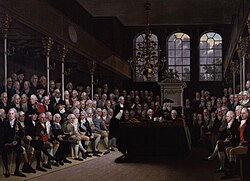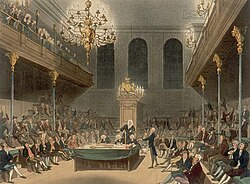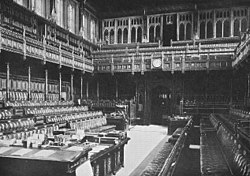House of Commons of the United Kingdom
The House of Commons is the lower house of the Parliament of the United Kingdom. It is made up of Members of Parliament elected by the people. Sometimes it is called the 'lower house'. (The 'upper house' is called the House of Lords.) Other countries also have a bicameral parliament with a House of Commons working in the same way.
House of Commons | |
|---|---|
| 59th Parliament | |
 Logo of the House of Commons | |
| Type | |
| Type | of the Parliament of the UK |
| Leadership | |
Sir Lindsay Hoyle since 4 November 2019 | |
Nus Ghani, Conservative since since 23 July 2024 | |
Sir Keir Starmer, Labour since 5 July 2024 | |
Lucy Powell, Labour since 5 July 2024 | |
Sir Alan Campbell, Labour since 5 July 2024 | |
Kemi Badenoch, Conservative since 5 July 2024 | |
Chris Philp, Conservative since 8 July 2024 | |
Stuart Andrew, Conservative since 5 July 2024 | |
| Structure | |
| Seats | 650 |
 | |
Political groups | HM Government
|
Length of term | Up to five years[a] |
| Elections | |
| First-past-the-post | |
Last election | 4 July 2024 |
Next election | No later than 15 August 2029 |
| Redistricting | Every eight years, proposed by the boundary commissions |
| Meeting place | |
 | |
| House of Commons chamber Palace of Westminster City of Westminster London, England United Kingdom | |
| Website | |
{{URL|example.com|optional display text}} | |
In the British parliament, there are 650 Members of Parliament or MPs. Each MP represents a constituency, which covers an area of the country. The people of each constituency vote at a general election or a by-election to choose one person to represent them in the House of Commons. Usually, the people choose someone who belongs to a political party. When all the parties get together, the party or coalition with the most members is the government and runs the country. The leader of that party is called the Prime Minister.
The House of Commons hold their meetings in the Palace of Westminster. Their chief officer is the Speaker of the House, who is elected by MPs. The current Speaker is Lindsay Hoyle, who was elected in 2019. The Clerk of the House of Commons is the Principal Adviser to the Speaker. The Serjeant-at-Arms is in charge of the security.
Election results since 1945
| Year | Conservative | Labour | Liberal & SDP | SNP | Others |
|---|---|---|---|---|---|
| 1945 | 197 | 393 | 12 | 0 | 38 |
| 1950 | 298 | 315 | 9 | 0 | 3 |
| 1951 | 321 | 295 | 6 | 0 | 3 |
| 1955 | Winston Churchill resigns and Anthony Eden becomes Prime Minister | ||||
| 1955 | 345 | 277 | 6 | 0 | 8 |
| 1957 | Anthony Eden resigns and Harold Macmillan becomes Prime Minister | ||||
| 1959 | 365 | 258 | 6 | 0 | 1 |
| 1963 | Harold Macmillan resigns and Alec Douglas-Home becomes Prime Minister | ||||
| 1964 | 304 | 317 | 9 | 0 | 0 |
| 1966 | 253 | 364 | 12 | 0 | 1 |
| 1970 | 330 | 288 | 6 | 1 | 5 |
| 1974 | 297 | 301 | 14 | 7 | 16 |
| 1974 | 277 | 319 | 13 | 11 | 15 |
| 1976 | Harold Wilson resigns and James Callaghan becomes Prime Minister | ||||
| 1979 | 339 | 269 | 11 | 2 | 14 |
| 1983 | 397 | 209 | 23 | 2 | 19 |
| 1987 | 376 | 229 | 22 | 3 | 21 |
| 1988 | The Liberal and SDP parties merge and Form The Liberal Democrats | ||||
| Year | Conservative | Labour | Lib Dems | SNP | Reform | Others |
|---|---|---|---|---|---|---|
| 1990 | Margaret Thatcher resigns and John Major becomes Prime Minister | |||||
| 1992 | 336 | 271 | 20 | 3 | 0 | 21 |
| 1997 | 165 | 418 | 46 | 6 | 0 | 24 |
| 2001 | 166 | 413 | 52 | 5 | 0 | 23 |
| 2005 | 198 | 355 | 62 | 4 | 0 | 23 |
| 2007 | Tony Blair resigns and Gordon Brown Becomes Prime Minister | |||||
| 2010 | 306 | 258 | 57 | 6 | 0 | 23 |
| 2015 | 330 | 232 | 8 | 56 | 0 | 24 |
| 2016 | David Cameron resigns and Theresa May becomes Prime Minister | |||||
| 2017 | 317 | 262 | 12 | 35 | 0 | 24 |
| 2019 | Theresa May resigns and Boris Johnson becomes Prime Minister | |||||
| 2019 | 365 | 202 | 11 | 48 | 0 | 24 |
| 2022 | Boris Johnson resigns and Liz Truss becomes Prime Minister | |||||
| 2022 | Liz Truss resigns and Rishi Sunak becomes Prime Minister | |||||
| 2024 | 121 | 411 | 72 | 9 | 5 | 32 |
House Of Commons Of The United Kingdom Media
William Pitt the Younger addressing the Commons in The House of Commons, 1793–94 by Anton Hickel
The House of Commons in the early 19th century by Augustus Pugin and Thomas Rowlandson
The old Chamber of the House of Commons built by Sir Charles Barry was destroyed by German bombs during the Second World War. The essential features of Barry's design were preserved when the chamber was rebuilt.
Notes
- ↑ Current law passed by Parliament limits the term of the House of Commons to five years. However, since Parliament is sovereign, Parliament can extend its term for as long as it pleases.[1] The last time this occurred was during World War II when Parliament voted to extend the term of the House of Commons multiple times until the conclusion of the war, with that Parliament existing for ten years instead of five years.
References
- ↑ Forsyth, Christopher (1 January 2011). "The definition of Parliament after Jackson: Can the life of Parliament be extended under the Parliament Acts 1911 and 1949?". International Journal of Constitutional Law. Oxford University Press. 9 (1): 132–143. doi:10.1093/icon/mor019. OCLC 5113464158. S2CID 144226994.






